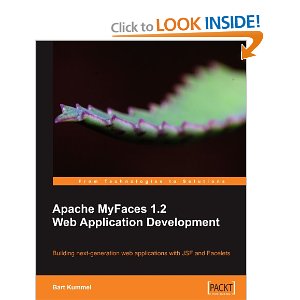 Book Description
Book Description
Hypes and trends (such as Web 2.0) cause a change in the requirements for user interfaces every now and then. While a lot of frameworks are capable of meeting those changing requirements, it often means you as a developer need in-depth knowledge of web standards, such as XHTML and JavaScript. A framework like Apache MyFaces that hides all details of how the page is rendered at the client and at the same time offers a rich set of tools and building blocks could save you a lot of time, not only when you’re building a brand new application but also when you’re adapting an existing application to meet new user interface requirements.
This book will teach you everything you need to know to build appealing web interfaces with Apache MyFaces and maintain your code in a pragmatic way. It describes all the steps that are involved in building a user interface with Apache MyFaces. This includes building templates and composition components with Facelets, using all sorts of specialized components from the Tomahawk and Trinidad component sets and adding validation with MyFaces Extensions Validator.
The book uses a step-by-step approach and contains a lot of tips based on experience of the MyFaces libraries in real-world projects. Throughout the book an example scenario is used to work towards a fully functional application when the book is finished.
This step-by-step guide will help you to build a fully functional and powerful application.
What you will learn from this book
- Create appealing and easy-to-use templates with Facelets
- Assure reusability of your code by constructing composition components
- Build consistent looking and usable pages using Trinidad components
- Use the advanced components from the Tomahawk library, that go way beyond the JSF standard
- Enhance your web application by enabling AJAX functionality without writing JavaScript code yourself
- Create dynamic applications that fit the corporate style and color scheme of your company by using the extensive skinning capabilities of Trinidad
- Prevent the duplication of validation rules by adding JPA annotation-based validation with ExtVal
- Optimize your JSF application in terms of performance and page size
Approach
The book is written as a step-by-step, example-driven tutorial designed to be worked through step by step working on the example code as you learn. A fun example scenario is used throughout the book and of course all source code is available to download from the author’s web site. The book is packed with tips and tricks, based on experience with MyFaces in real-life projects.
Who this book is written for
This book is intended for Java developers who want to develop web frontends for their enterprise applications using Apache MyFaces as JSF implementation. Some basic knowledge of JSF is expected.
About the Author
Bart Kummel studied Electrical Engineering at the Delft University of Technology and graduated with honors at the Hogeschool van Amsterdam, with the specialization Technical Computer Sciences. After four years of developing embedded software for a security systems manufacturer, he switched to enterprise software and started to work at Transfer Solutions B.V. in 2005. Transfer Solutions is a consulting company based in the Netherlands, which specializes in Oracle and Java technology. As a consultant he gained a lot of experience with JEE in general and JSF, Apache MyFaces, and Trinidad in particular. Bart also acts as a trainer in courses on Object Orientation, UML, Java, JEE, and JSF at Transfer Solutions’ education department.
Book Details
- Paperback: 408 pages
- Publisher: Packt Publishing; 1st New edition edition (March 2, 2010)
- Language: English
- ISBN-10: 1847193250
- ISBN-13: 978-1847193254
- File Size: 13.3 MiB
- Hits: 1,782 times